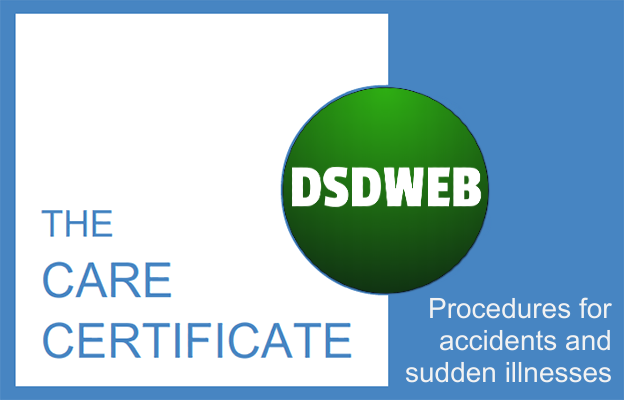This page is designed to answer the following questions:
- 13.4b Describe the procedures to be followed if an accident or sudden illness should occur (Care Certificate, Standard 13: Health and safety)
- 3.2 Outline the procedures to be followed if an accident or sudden illness should occur (Level 2 Diploma in Care, Health, safety and wellbeing in care settings)
- 1.2 Explain the main points of health and safety policies and procedures agreed with the employer. (Level 3 Diploma in Adult Care, Promote health, safety and wellbeing in care settings)
- 2.3 Explain procedures to be followed if an accident or sudden illness should occur (Level 4 Diploma in Adult Care, Health and Safety in Health and Social Care Settings)
NOTE: This page has been quality assured for 2023 as per our Quality Assurance policy.
When an accident or sudden illness occurs, you must follow the procedures in your employer’s agreed ways of working. Therefore, you will need to read, understand and be confident in implementing your employer’s health and safety policy.
If it is safe to do so, you should ensure the safety and comfort of the individual. Do not administer first aid unless you have had the correct training as you could potentially do more harm than good. Call for help from a qualified first-aider. If necessary, call the emergency services for assistance.
If the victim of the accident or sudden illness is a service user, their care plan may specify specific actions that should be taken. For example, if an individual has epilepsy and they suffer a seizure, the protocol may be to hold their hand and prevent them from hurting themselves until the seizure passes. You may not need to call for emergency support until the seizure has been going on for a certain amount of time.
Even if you are not qualified to administer first-aid, providing reassurance, calling for help and contacting the emergency services are important responsibilities. You may also need to make the environment safe to prevent further or additional harm from being caused. You should also ensure that the individual’s dignity is protected – for example, if they fell in the shower you should ensure that they are covered appropriately. If there is a qualified first-aider available, you should assist them by following their instructions. This could involve finding blankets to keep the individual warm or locating a defibrillator.
Some basic life support tasks that you may be able to perform, even if you are not a qualified first-aider include those described by the DRABC acronym. They are:
- (D)ANGER – ensure it is safe to approach the individual without putting yourself in danger. Only when it is safe to do so should you continue.
- (R)ESPONSE – check to see if the individual is responsive by calling their name and talking with them. You may also gently but firmly shake them by placing your hand on their collarbone. At this stage, you should also shout for help.
- (A)IRWAYs – if they are unresponsive, firstly lightly tip back their head by holding their chin and forehead to open their airways
- (B)REATHING – check that the individual is breathing by listening for the sound of breath as well as observing if their chest rises and falls. If they are breathing but unconscious, please them in the recovery position.
- (C)IRCULATION – check that the individual has a pulse. At this stage, you should also call for emergency services.
You should record accidents and sudden illnesses in line with your employer’s agreed ways of working. This may be an accident book, form or online system. You should ensure all records are accurate and legible. You should also inform your manager or other relevant person/people at your earliest convenience. Management should then make appropriate notifications – this could include notifying the individual’s next of kin, the Health & Safety Executive (HSE) as part of the Reporting of Injuries, Diseases and Dangerous Occurrences Regulations (RIDDOR) and the Care Quality Commission (CQC).
Following an accident or sudden illness, you may want to reflect on what has happened. If it was serious, then you may need additional support to help manage your emotions. Reflection can help you to identify areas that you may wish to perform differently in future and help you to gain insights on ways to prevent it from happening again. Any recommendations that you have should be passed on to your manager.
Example question and answer
Explain the procedure to be followed in the event of an accident or sudden illness.
In the event of an accident or sudden illness, the individual should be assessed immediately and first aid administered by the first responders (if needed and they have adequate training). The person responding to the accident or sudden illness should also shout for help from others and ask them to call the emergency services if required.
When the individual is stable, management should be informed.
As soon as is viably possible, the accident or sudden illness should be recorded on an Accident/Incident Form.

